The battle
80th Infantry Division “Blue Ridge”
Organisation
- Reconnaissance
80th reconnaissance troop - 80th division infantry
317th infantry regiment
318th infantry regiment
319th infantry regiment - 80th division artillery
313th field artillery battalion
314th field artillery battalion
315th feld atillery battalion
905th field atillery battalion - Special troops
80th signal company
780th ordnance company
80th quartermaster company
305th engineer battalion
305th medical battalion
80th CIC detachment
History
Origins
Same as the majority of American Divisions, which fought during the Second World War, 80th ID draws its origins from a preceding unit. A 80th ID had been created in August 1917 in Camp Lee. Composed mainly of conscripts from Pennsylvania and Virginia, this division of 23.000 men was sent to France in June 1918.
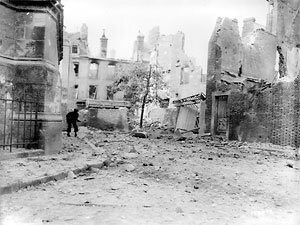 August 1944 - a soldier of 80th ID advances in Argentan, taking
August 1944 - a soldier of 80th ID advances in Argentan, taking
cover from German sniper fire. © National CR Basse-Normandie
/ National Archives USA It was committed in three major battles: fighting in Artois, the Somme, then on the Meuse front. During those engagements, its eagerness made it to be classified better division by War Department. It went back to the United States in May 1919 and was demobilised on June 26th of the same year.
80th ID was reborn on July 15th, 1942, in Camp Forrest, Tennessee. It spent nearly two years on training. It took part successively in manoeuvre’s of Phillips Camp then to those of California desert. Quickly considered being combat-suitable, it was sent to Scotland on July 7th, 1944. After last preparations, it was moved towards the southern coast. It unloaded in Utah Beach on August 2nd.
In Normandy
After gathering in the sector of Saint Jores, 80th ID was declared operational on August 8th. On this date, it received task to descend south in order to stop the German counter-attack, Lüttich. This latter having failed quickly, the 80th arrived too late in the area of Mortain.
Attached successively to 15th then 20th Corps, 80th ID then turned eastwards. Crossing Mayenne, with Evron and Saint-Suzanne as its objective, it seized the latter August 10th. It continued then the envelopment of the German troops towards north with the 2nd Free French division and 90th US ID.
Its mission consisted in seizing Argentan, a task that seemed within reach. However, Bradley had ordered from August 14 a pause in the offensive. When the GI' S of 80th ID set out again with the attack, they ran up against the savage resistance of the 116. German PzD, which had had three days to strengthen its defences. After the failure of August 15/16th attacks, the city underwent the repeated bombardment of aviation and allied artillery. A new attempt launched August 18th also failed. Finally, when 317th regiment penetrated in the city August 20th, it found the city empty, its defenders having had plenty of time to evacuate it…
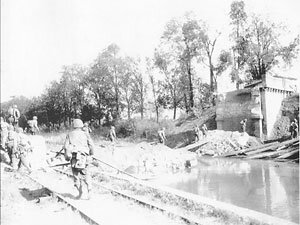 September 12th, 1944 – 318th Regiment crosses a canal on an impr-
September 12th, 1944 – 318th Regiment crosses a canal on an impr-
ovised bridge, in direction of the Moselle.
While the engagements for Argentan still continued, a detachment of the division had progressed northwards, beyond the city. August 19th, it cut the road Argentan-Trun, driving back the Germans towards the plain the Dives. With the end of the fighting for the Falaise pocket, 80th ID was employed to recover the thousands of German prisoners.
In Lorraine
Once the battle of Normandy finished, 80th ID took part in the race towards the east of the 3rd Army. On the heels of the withdrawing Germans, it crossed the Seine, then the Marne. It liberated Châlons on August 29th, then Commercy on September 1st. The following day, it released Saint-Mihiel, where it had fought 26 years earlier.
On September 4th, 80th ID succeeded in establishing the first bridgehead of the 3rd Army on the east bank of the Moselle, north of Toul. It moved then towards Nancy on the side of 35th ID, but met important German opposition, in the form of several armoured brigades that were thrown in the battle.
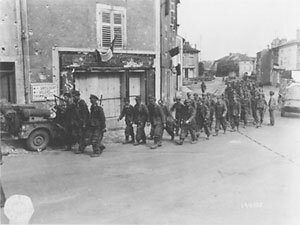 September 13th, 1944 - column of German prisoners captured by
September 13th, 1944 - column of German prisoners captured by
317th regiment.
From September 11th, it ran up against the resistance of the 17th SS Pz G-Division. In Pont-à-Mousson, it underwent a strong counter-attack, which obliged it to give up part of the conquered ground. It took a week of engagements to secure the neighbourhoods of Nancy - cities like Dieulouard, Loisy or Atton were bitterly disputed. Added to the supply problems, which disturbed then all the American army, the defence of the line of the Moselle by the forces of Reich froze the front on the Seille River until the beginning of November.
On November 8th, 80th ID attacked in direction of the Saar. It cleaned banks of the Seille, captured Abaucourt, then advanced towards Nied. The seizure of an intact bridge in Han-sur-Nied made it possible to establish a bridgehead then turn the German backs. These operations obliged the Germans to withdraw from Metz, allowing the capture of this city by 5th and 95th ID. November 25th, 80th ID stormed the Maginot line. The capture of several forts the same and the following day - Laudrefang, Kinseling, Einseling and Quatre Vents - opened the road of Saint-Avold and the Saar. 80th ID managed to progress up to 5 kilometers of Saarbrücken, before being replaced on December 7th.
From Ardennes to Bavaria
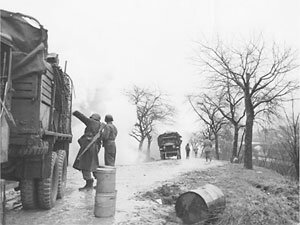 February 8th, 1945 - a smoke generator hides the location of the
February 8th, 1945 - a smoke generator hides the location of the
crossing of 317th regiment on Our River.
From December 16th, 80th ID was redeployed against the Siegfried line, with mission to breach it then launch an offensive around Zweibrüicken. However, the offensive of the Ardennes started by von Rundstedt modified the American plans: like all the 3rd Army, 80th ID was reoriented north and directed to Luxembourg, with mission to defend the southern flank and cover approaches to the capital of the Grand Duchy.
From December 22nd, the 80th division tackled enemy positions, which it hustled in Ettelbruck. It joined then the 4th AD in its race towards Bastogne - tanks and infantry managed to break the encircling of the city on December 28th. It continued the offensive at the beginning of January, and pushed back the enemy at Goesdorf the 7th, then beyond the rivers Clerf and Wiltz, January 26th.
From February 7th, division penetrated in German territory. It attacked on Our and the Sure, managing to cross this latter in Wallendorf the evening. However, the strong rains and the floods which resulted prevented engineers from building a bridge up to the 12th. Finally, it is only on February 15th that 80th ID managed to definitively overcome the Siegfried line. It progressed then quickly following the 4th AD, crossed Prum, then Kyll rivers on the beginning of March. From March 9th, it was employed to clean this area, while 5th ID took over with the 4th AD.
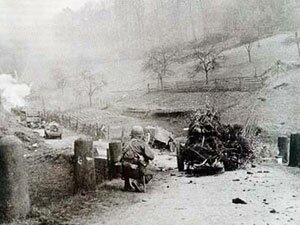 March 1945 – 80th ID fights in Frankenstein.
March 1945 – 80th ID fights in Frankenstein.
During following weeks, 80th ID progressed by the Saar and Palatinat, until Kaiserlautern. It obliqued then east to arrive on March 20th on the Rhine, around Ludwigshafen. It crossed the river March 28th, then moved towards the Northeast. At the end of one week of engagements, it captured Kassel (April 6th). Advancing always more into the east, it seized Erfurt (April 12th), then Weimar, and then Gera (April 14th).
From April 21st, division was put at rest in the area of Nuremberg as an occupation force. While the war ended, it carried out its last mission. It crossed the Danube in Regensburg, and, on May 1st, accepted the capitulation of the 6. German Army. May 4th, it released Ebensee, a camp of concentration attached to Mauthausen.
After the German capitulation, 80th Infantry Division served briefly as occupation force. It was repatriated in the United States in December 1945 and dissolved immediately after. Since August 1944, 80th ID had fought 239 days. Its losses are 2.614 dead and 10.795 wounded.













 www.evl.pl
www.evl.pl